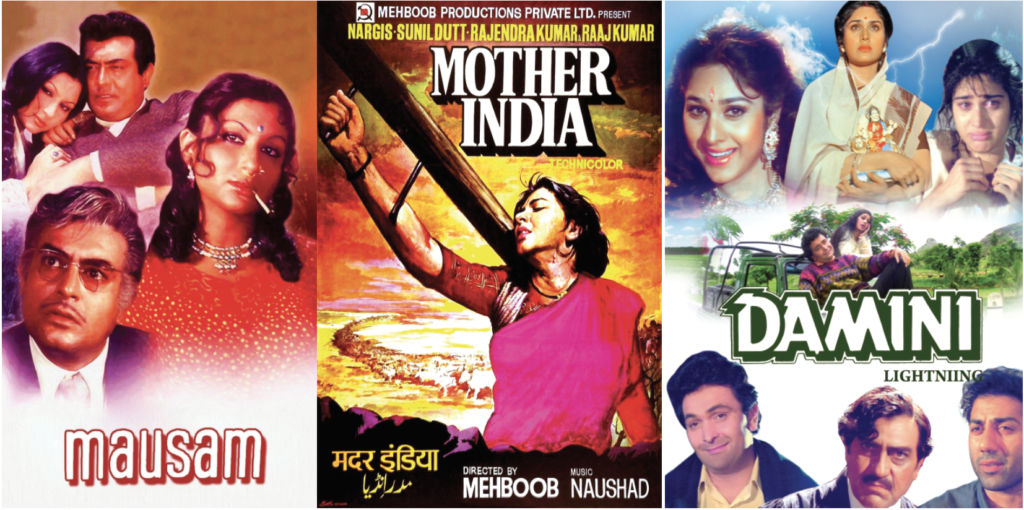The gang-rape of a young Dalit girl in UP’s Hathras preceded and followed by several rapes of little girls by their cousins, of a teenager by an uncle, a student by her tutor, throw up the ironical reality of contemporary Hindi cinema where rape as a marketing strategy to draw the crowds through titillating frames, or, using it as a plot strategy to pull audience has faded almost into obscurity.
It would be interesting to look at the presentation of rape in Bollywood cinema of the 1980s and 1990s to try and discover how this is no longer a presence in contemporary Bollywood cinema today.
Rape is one of the many manifestations of violence against women placed in a much wider continuum of socially and politically inflicted violence which includes within its canvas, systematic violations of women’s economic and political rights. Society has castrated women in every which way and rape is just one dimension of this castration. A means by which she is politically manipulated to harbour and nourish feelings of guilt, fear, distrust, anger and frustration. The law, ironically, chooses to harass and distrust the victim rather than give her justice. In all rulings on rape cases, people conveniently forget that rape bears a direct relation to all power structures in a given society.
This relationship is not a simple, mechanical one but involves complex structures reflecting the interconnectedness of gender, caste and class oppression that characterises society. If we refuse to understand the nature of sexual violence as is mediated by caste, class, race and state power, we have no hope of developing strategies that will eventually allow us to purge our society of oppressive, misogynist violence. The main problem lies in that we do not realise that to grasp the true nature of sexual assault, we must place it within its larger political context. If we wish to understand the true nature of rape as experienced by women as individuals, we must be aware of its social mediations. The high incidence of casteist rape, incestuous rape, marital rape and communal rape in India against the backdrop of a corrupt and tottering democracy, heightening poverty, ethnic terrorism and other atrocities like war and terrorism all of which involve women caught in no-exit situations because rape is used as a weapon of revenge.
Rape in cinema, has certain unwritten specific functions: fragmentation of the scene by camera movements, construction of the representational space by depth of field, deffraction of light, and colour effects — in short, the process of fabrication of the film from decoupage to montage. It all happens as if a long-drawn-out sequence of rape places cinema on trial, converting every film depicting rape graphically and voyeuristically into a soft-porn product placed for sale in the open market.
Rape projected in cinema of 80s and 90s
No Indian film on rape has ever evoked the kind of controversy Insaf KaTarazu (1980) did. It created controversy over the Censor Board’s clearing the film with an ‘A’ certificate. But there were reports about some of the censored scenes having been later inserted in some theatres. Feminist readings and analysis of filmic texts were unknown in India then. This is precisely why hardly anything came out of the critical attacks on the film. Today, with the rise in ‘wholesome family entertainment’ in mainstream Indian cinema, rape seems to have lost its box-office value, which is a good thing.
Insaf KaTarazu set a new trend in the mainstream at that time in which some films pretended to portray the evils of rape. But the medium of cinema managed to produce just the opposite effect which was actually the film-maker’s intention. Plagiarised from the Hollywood film Lipstick, B. R. Chopra’s film unfolded the story of two sisters wrongly raped by the same man (Raj Babbar), distanced through place and time. Though this formed the crux of the narrative, the image produced through visuals, sound, characterisation and context revealed the clever use of the medium of cinema to play up to the sexual fantasies of the males in the audience, which automatically ensured a full house for each show.
Films that tackled rape sensitively
But there have been films where rape was not only a part of the story, but was treated with great subtlety and finesse. In Gulzar’s Mausam (1975), one of the most brutally frank essays on prostitution, Kajri (Sharmila Tagore as the daughter) makes her way through the woods on her way back from the dispensary carrying medicine for her ailing mother (Sharmila as the mother). Instead of focussing on Kajri, the camera pans on the wall where Kajri, in her struggle with the rapist, (the proverbial village ‘uncle’), drops the bottle of medicine. Her piercing scream fills the sky, superimposed with the sudden burst of bird cries in the air. The upturned medicine bottle on the parapet shows the liquid trickling down the wall, ever so slowly, red in colour, like blood.
In Mehboob’s Mother India (1957), Radha visits the lecherous money-lender. The next shot cuts to a scene showing Radha (Nargis) staggering back home, her hair awry, her bindi a diffused blur, the mangalsutra torn off her neck. In retrospect, the signs appear cliched, but the cliche is undercut by the anger in Radha’s eyes, which spells out the desperation and the vulnerability not only of being a woman, but also of being a woman who is poor, young, beautiful and alone. Another brilliant tackling of rapes of the same woman came across in Shekhar Kapoor’s controversial The Bandit Queen based on the true story of Phoolan Devi. But this was an off-mainstream film.
Raj Kumar Santoshi’s Damini (1993) offers a unique perspective on rape. The rape victim here is economically and socially so weak and vulnerable, that she is forced to accept the violation of her body by a gang of young boys led by her employer’s son. She is a housemaid in an apparently modern, affluent business family. But help comes from a totally unexpected quarter: a daughter-in-law of the family, who is of lower-middle-class upbringing, rises to her cause, even while the girl is dying on a hospital bed.
The picture is changing
Is this fade-out of rape in cinema the result of too many brutal, cold-blooded and calculated gang-rapes in real life? Or, is it because the very trend, perspective and treatment of plot, cinematography, narrative and editing have changed over time and the audience is not interested in titillating rape scenes? Or is it because rape has been replaced by countless item numbers in mainstream cinema that have perfected themselves to an aesthetic expression that is now the subject of scholastic research across the world? Or, maybe, the trend of Bollywood cinema has evolved itself into a more globalised expression to reach out beyond Indian borders? Perhaps, today’s leading ladies who are very bold in their approach to cinema, are unwilling to feature in rape scenes? The lone exception in very recent cinema is Pink which is attempted rape and not rape. Think about it.
The OTT platforms with serials such as Delhi Crime have explored the more significant areas surrounding rape such as offering a positive image of the police in trying to nab the culprits in the terrible Nirbhaya case. Guilty deals also with the subject of rape within a college campus and though there are brutal scenes of rape that suggest that the girl was asking for it, the film offers a moral lesson on how young college girls and boys should not always throw caution to the wind to be trapped in no-exit situations that could lead to rape. Mainstream cinema that draws a massive audience can do a lot of good by handling the subject more sensitively so as to highlight crime and violence against women and also project a more realistic role of the law makers, courts, police and the media.
1. YannLordeau, ‘Le sex froid (du porno dela),’ Cahiers du cinema, (No.289, June 1978), pp. 49,52 and 61.


 [/column]
[/column]